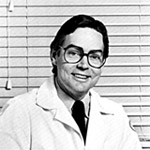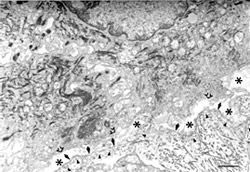Establishing the Scientific Basis for Using UV Light to Treat Psoriasis and Vitiligo

Carter, Martin
Courtesy of the Rockefeller Archive Center
In the 1980s, D. Martin Carter (1936-1993) established one of the nation's most comprehensive centers for the study and treatment of skin diseases at The Rockefeller Hospital. Combining laboratory and clinical studies, Carter and his colleagues pioneered new treatments as well as rigorous studies of the basic biology of conditions both common, like psoriasis, and rare, including epidermolysis bullosa, a group of inherited diseases in which the skin is fragile and blisters easily.
Carter's research helped lay the foundation for using PUVA-a combination of psoralens, plant-derived substances that sensitize the skin to light, with exposure to the "A" band of ultraviolet light-to treat psoriasis and vitiligo, another skin condition. Carter was an investigator in the first national study group of this widely used therapy. In addition to showing the treatment's effectiveness, this research revealed the potential for PUVA to damage chromosomes and lead to skin cancer. Carter pursued further investigations of DNA repair mechanisms after psoralen-induced damage and also developed blood tests for minimizing cancer risk from PUVA therapy.
The interactions between environmental factors, genetics, and aging on skin were the subjects of much of Carter's research, including his studies of wound healing. In research on keratinocytes, the most common cell type in the outer layer of the skin, he and Arthur Bailin found that levels of oxygen affected the growth and lifespan of the cells when grown in culture. Carter also studied the underlying mechanisms that lead to extensive blistering among people with epidermoslysis bullosa. During Carter's tenure, The Rockefeller Hospital became a referral center for people with psoriasis, epdermolysis bullosa, Fanconi anemia (which may affect the skin as well as cause bone marrow failure and various congenital malformations), and slow healing wounds. His clinical studies of medications, dressings, and skin grafts at the Rockefeller Hospital led to changes in therapy that improved the lives of many patients.

Electron micrograph of junctional epidermolysis bullosa. Courtesy of Lynne T, Smith, Seattle, WA
Carter also was a supportive and effective mentor, and his legacy to The Rockefeller Hospital includes the laboratories of two of Rockefeller's current faculty: James G. Krueger, head of the Laboratory of Investigative Dermatology, and Arleen Auerbach, director of the Laboratory of Human Genetics and Hematology.
D. Martin Carter received the AB from Dartmouth College (1958), the MD from Harvard Medical School (1961), and the PhD from Yale University (1971). After internship and residency at the University of Rochester (1961-1963) and a fellowship at the U.S. Centers for Disease Control (1963-1965), he was a resident in dermatology at the University of Pennsylvania (1965-1967). He then earned his PhD at Yale under Charles Radding, and joined Yale's dermatology faculty in 1971, becoming full professor in 1977. He was Yale's first Howard Hughes Medical Investigator (1970-1977). In 1981 Carter moved to The Rockefeller University as professor and senior physician. He was also co-leader of the division of dermatology at New York Hospital-Cornell Medical Center. Carter served as president of the Society for Investigative Dermatology, and he was a founding member of the National Epidermolysis Bullosa Registry and the American Skin Association (ASA). The ASA presents an annual award in his honor. At Rockefeller, the endowed D. Martin Carter Professorship in Clinical Investigation has been held since 2004 by James G. Krueger.
Selected Publications
Ljunggren B, Carter DM, Albert J, and Reid T. Plasma levels of 8-methoxypsoralen determined by high-pressure liquid chromatography in psoriatic patients ingesting drug from two manufacturers. J Invest Dermatol, 1980, 74: 59-62
Goldstein DP, Carter DM, Ljunggren B, and Burkholder J. Minimal phototoxic doses and 8-MOP plasma levels in PUVA patients. J Invest Dermatol, 1982, 78: 429-433
Carter DM and Goldstein DP. Quantitative tests for psoralens in the blood: methods and uses in monitoring psoralen and longwave radiation therapy. Natl Cancer Inst Monogr, 1984, 66: 69-72
Carter DM and Lin AN. Wound healing and epidermolysis bullosa. Arch Dermatol, 1988, 124: 732-733
Lin AN and Carter DM. Epidermolysis bullosa: when the skin falls apart. J Pediatr, 1989, 114: 349-355
Further Reading
Lerner AB. Tribute: David Martin Carter, MD, PhD. J Invest Dermatol, 1994, 102: 397
http://www.nature.com/jid/journal/v102/n4/index.html
Lin AN and Carter DM. Epidermolysis Bullosa: Basic and Clinical Aspects. Springer, 1992
Links
American Skin Association
http://www.americanskin.org/
